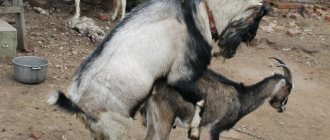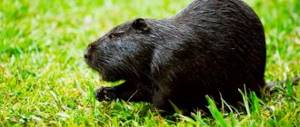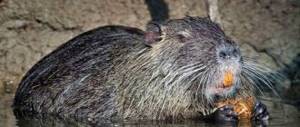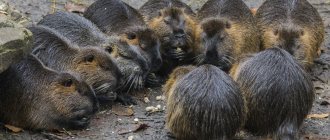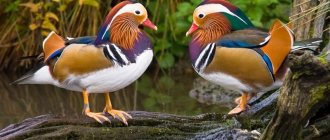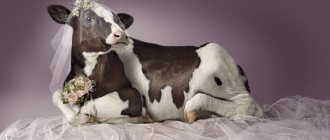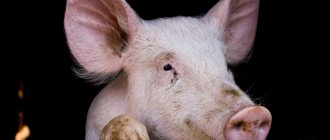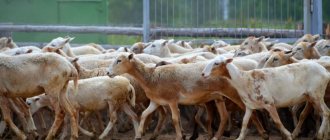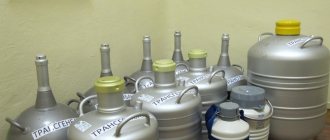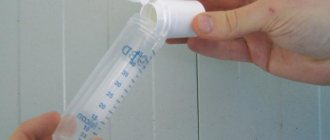Selection of parents
The average fertility rate for nutria is 5-6 individuals per litter; a maximum female can produce 18 puppies.
Productivity depends on several factors:
- conditions of detention;
- readiness of animals to mate (hunting);
- age and health of parents.
Reproductive age of nutria
For breeding animals, sexually mature individuals with a healthy reproductive instinct are needed. When properly maintained, nutria become sexually mature at the age of 5 months.
But early mating has its own nuances:
- problem with conceiving offspring later;
- small offspring;
- a large number of stillborn puppies;
- the male does not cover well;
- offspring with low viability.
If mating is delayed, the animals become fat and lose their sexual instincts. To get healthy offspring, you need to mate healthy individuals weighing about 4 kg. The female is 6–8 months old, the male is 7–9 months old.
Important! It is not recommended to breed a female more than 3 years old: aggression towards her own offspring is possible, even cannibalism.
Determination of sex in animals
The appearance and behavior of females and males are no different, so it is possible to determine who is who only by the genitals of the animals. The individual is taken by the withers at the back of the head, turned belly up, and the genitals are examined.
In a male specimen, at a distance of 3–5 cm from the anus, there is a penis directed upward, and the seminal testicles can be felt there. The female has a genital slit near the anus.
Signs of the hunt
The first signs of readiness for mating can be seen in behavior:
- The female shows unusual activity: she runs around the cage, scratches the floor with her paws, and raises her tail. She may experience frequent urination and loss of appetite. The genitals become engorged with blood and become bright red.
- The male shows interest by quiet whistling, his body shaking.
- After replanting, the individuals sniff each other, the females pretend to jump away, flirting with the male.
- The activity of males can be constant, estrus in females occurs approximately once a month, hunting lasts about 40 hours.
Read how to build a nutria farm.
Inexperienced farmers have a question: why sometimes the female chases her partner around the cage, not letting her near her. Nutria can attack a partner seeking to mate if it has not yet come into estrus (mucous discharge from the genitals).
Video: how to determine “hunting” in a female nutria
Mating process
To successfully propagate his wards, the farmer must delve into all the nuances of the process. During mating, about 4–6 coitus occur, lasting up to 2 minutes. Then follows a short rest. The greater the number of coitus, the greater the number of puppies you can expect in the litter.
Important! Before creating a group or family, you need to examine the genitals of the inseminating males. The penis may be covered with matting hair, which will interfere with mating - the organ needs to be cleaned.
Mating age
It is most rational to mate females at the age of 6-8 months, males at 7-9 months with a live weight of at least 3.5-4 kg. When females mate at an earlier age, their fertility and fertility usually decrease, the number of stillborn puppies increases, and the weight of live puppies at birth decreases. In addition, when introduced early to females, males sometimes develop a habituation effect and refuse to cover females in heat.
In order to reduce labor costs for mating, distributing food and laying bedding, as well as reducing the need for cages for animals of the main herd, family breeding of nutria is used, i.e. they constantly keep a male with several females (three, less often four, five) in one cage.
Nutria propagation methods
When choosing the frequency of matings and the season for replenishing the herd, you need to take into account the purpose of breeding animals: meat or skins, both directions . For this, a schedule is drawn up, for example, to obtain offspring at the beginning of the year, mating is carried out in the 3rd decade of August, the second mating is scheduled for March - May. In this way, the quality and quantity of offspring is obtained without compromising the productivity of the herd.
The jamb method
This option is suitable for breeding inexperienced females who have not yet given birth. A senior experienced breeder is placed in a group of about 14 individuals of the same age and weight. If mating occurs, after 1.5–2 months the pregnant individuals are placed in separate cages.
The penned method of propagation is similar to the shoal version, but is relevant on an industrial scale. The method differs in the number of herds: for every 100–200 females, 10–20 males are planted.
Replanting
The manual method or replanting is the formation of one productive pair. The female is placed in a cage with the breeder and their behavior is observed. If the animals do not chase each other and show interest, then after whelping, in due time, they will be brought together again.
Did you know? Nutria can stay underwater for 10 minutes. This ability is given to them by the special structure of the nostrils with the “obturator” muscle.
Family method
A family is formed from 3–5 females raised together, who may be related, and an unrelated male. The family group is maintained for the entire breeding period. The babies are taken away from the family after 2 months and raised separately.
This method has one peculiarity - it is difficult to establish maternal kinship if several individuals have whelped. A significant disadvantage is that with a large number of adult animals there is a risk of trampling the cubs.
Mating methods
There are several methods for mating nutria. Each of them has advantages and disadvantages. Mating methods:
- free;
- manual;
- jamb;
- family.
Free mating method
The free-range method involves keeping males and females together on a permanent basis. Usually there is 1 producer for every 10 or 12 individuals. Animals live together all the time. Pregnant nutria are gradually removed. Disadvantages of the free method:
- it is impossible to determine from which sire the offspring were obtained;
- fights often occur in the herd;
- Pregnant nutria that are not identified in time and not hatched show aggression towards their fellow tribesmen.
Manual method
The manual (replanting) method is only applicable to nutrias that have whelped. It means that the farmer places the female with the male the day after the cubs are born.
Nutria before mating
To “catch” the time of sexual estrus in female nutria, replanting is carried out within a week. On the 24th day after birth, the replantation is carried out again. Over the course of 7-8 days, the farmer arranges dates for the animals. If after this the nutria is not covered, then it is left alone until the end of lactation, and then transferred to schools for mating using the school method.
Sexual hunting in nutria lasts about 36 hours and occurs every 21-26 days. The placement of females in a cage with a male is repeated throughout the week to increase the likelihood of fertilization.
Attention! A whelped nutria should not be left in a male's cage for a long time, otherwise its milk production will decrease or mastitis will develop.
The jamb method
According to this method, young nutria that have not yet reached sexual maturity are kept in one pen. The school is formed from calm individuals, the mass of which is approximately the same (2.5-3 kg). One school contains from 3 to 14 female animals. Once they reach sexual maturity, an older male is placed with them. In this case, nutria mating occurs naturally. The farmer’s task is to periodically identify and remove pregnant individuals. Covered animals are transplanted every 15 days, leaving nutria in the school that do not show obvious signs of pregnancy. The fertilized ones are placed in separate cages, where whelping will occur.
Attention! If females are not covered for a long time, the manufacturer is replaced.
It is important to adhere to the rules regarding the formation of a joint. It’s not enough to just choose animals of the same age with a calm disposition; you need to take care to reduce the likelihood of fights at the stage of getting to know the nutria. To do this, all animals selected for the school are released into a cage or enclosure at the same time. Once in an unfamiliar environment, nutria will behave quietly. After some time they will get used to their new home and each other. If you let a newcomer into an already formed school, fights will certainly break out: the old-timers will begin to show their superiority.
The joint method is also used to mate those nutria that were not mated when kept freely during the lactation period. They form a separate joint. It consists of animals that previously lived in the same enclosure and are already familiar with each other. In this case, the breeding male is left the same if he has proven himself well.
Family method
This method of breeding nutria is reminiscent of the joint method with a slight difference. A school is formed from females of the same litter, that is, the females in it are sisters. The advantage of this method is that the animals hardly fight, since they grew up together. A breeder who is not a relative of the females lives in the same territory as them.
Family method of breeding nutria
You need to install several houses in the cage; they are occupied by whelped nutria and their offspring. After 1.5-2 months, the young animals are separated from their mothers and kept separately. One of the disadvantages of the family mating method is the inability to determine the identity of the cubs with the mother.
Reference. Nutria are almost never kept in separate pairs, since this method implies the need to purchase a large number of males.
Pregnancy and childbirth
Pregnancy can be detected by external signs and by palpation:
- at 28–30 days, a mucous reddish discharge appears from the female’s genital organ;
- on the 45–50th day, embryos are felt in the abdominal cavity (round formations with a diameter of 2-3 cm);
- at 60–70 days of pregnancy, the nipples swell;
- on the 127th–132nd day, labor begins.
Find out more about the features of caring for pregnant and newly hatched nutria.
Possible problems
Due to errors in the maintenance of pregnant nutria, dead puppies are born. During a difficult birth, the female, trying to pull out the baby, can independently bite it hard. And due to a lack of vitamins, especially primiparous individuals, eat healthy cubs.
Video: how nutria give birth
- Proper care of pregnant nutria:
- sufficient space in the cage;
- dry and clean bedding;
- availability of clean water in constant access;
- absence of sharp sounds near housing;
- Be sure to include succulent and protein foods in the diet;
- The food includes vitamins - phosphorus, calcium, vitamin A.
Caring for puppies
The chicks grow up quickly, after 2 weeks their weight doubles, and after 60 days - 5 times. The offspring exhibit amazing independence: on the 2nd day after birth, the cubs learn to swim and explore the space around them. If the birth occurs in winter, the room with the cubs must be insulated to eliminate the risk of disease.
Did you know? The location of the nipples on the sides of the nutria mother's sternum allows her to feed her babies directly in the water.
Typically, the mother feeds the offspring for no more than 30 days, after which the hatchlings switch to an adult diet. The young animals' menu mostly consists of succulent feed. You also need to add root vegetables, concentrated feed and vitamins to your diet, and be sure to add 0.5 g of salt.
Healthy young animals are active and have shiny fur. The puppies play, bathe, and quickly gain weight.
Seasonal breeding
Seasonal breeding of nutria eliminates many of the disadvantages of a year-round scheme. It has been determined that babies born in the first quarter are more profitable. They have time to grow before winter, and the fur acquires the necessary qualities. As a result, it is more rational for most female nutria to give birth in the first half of the year. Already from November to March (the fur acquires its best qualities), young individuals reach eight to nine months of age.
Seasonal breeding scheme:
Mating schedule This schedule provides for the mating of females during the 1st or 2nd heat after whelping.
During autumn mating, most of the eggs should be fertilized. Therefore, from the end of summer to the end of autumn, it is advisable to mate individuals of all ages, including those that were born at the beginning of the year. These females in this case will whelp in the first quarter of next year. Individuals that were not covered in the fall are often slaughtered for skinning. To ensure uniform whelping in the first quarter, during autumn mating, males are placed with a group of females in August, September, October from the twentieth of each month. To get another litter in the same year from females that whelped between January and February, you need to give birth last from March to April. Young animals that are born (from the first whelping) are usually slaughtered for skinning in the period November-December; the owner decides exactly how much to slaughter. Young animals born in the summer - in April the next year. Individuals from the second whelping are slaughtered in the second quarter of the following year, when they reach the age of nine months.
Nutria chew their tails: causes, prevention
Breeders are faced with the phenomenon of animals spoiling their own tails. The reason why animals chew their tail is considered to be a lack of nutrients in the diet.
Experienced nutritionists recommend including the following ingredients in the menu, especially in winter when there is little succulent food:
- vitamins - A, B1, B6, B9, B 12, D, E (Pushnovit complex);
- meat and bone meal, fish meal;
- chalk and salt;
- branches of bushes and trees (acacia, apricot, cattail, birch, grapevine, poplar).
The chewed tail is removed, preferably by a veterinarian, then the wound is cauterized with iodine or another antiseptic.
Reproduction of nutria requires attention and familiarity with the behavior of animals. The health of the wards is influenced by the conditions of detention and the provision of a balanced diet.
Definition of hunting
The period of hunting in female nutria can be determined by behavior and external signs. If the animal has become more active, eats less, urinates often, runs around the cage, paddles with its paws and lifts its tail, then the animal has begun to come into heat.
External signs of estrus are not clearly expressed. In some cases, it is determined by the genitals - redness and swelling.
The most reliable way to determine the onset of sexual heat is to place the female with the male.
The “playing” female will flirt with the male, follow him and sniff him. If the heat has not started, then the “bride” will reject the “gentleman”, scream loudly, try to hide, or try to fight with the “suitor”.
The female's hunting period lasts 2-3 days.
Nutria breeding
Achievement of puberty in both sexes occurs simultaneously at approximately 4-5 months of life. Adult males are constantly ready to mate. Typically, the menstrual period in females lasts from 24 to 30 days, in some cases it can be shortened to 15 days or increased to 40. After giving birth, the female returns to heat within 1-3 days. Usually sexual hunting lasts 36-40 hours. To satisfy their desires, animals mate 4-6 times at fairly short intervals.
Determining the onset of sexual heat in nutria is quite problematic. A sign of its onset may be the enlargement and redness of the genital loop that occurs in many females. But this method is not very accurate. Guaranteed sexual heat is determined only by the behavior of an adult male. Placed in the same cage with a female, he sniffs her and, if the female is in heat, shows her signs of attention: fawning, purring, maybe whistling, and after a certain period of time makes cages. The male, after sniffing, does not show interest in a female who has not entered the hunting period, and the female herself tries to avoid contact with the male.
The simplest way to mate nutria is the shoal method. Its essence is that one male sits in a cage with females, each male can serve from 5 to 15 females. The downside of the method is that females that have already given birth are quarrelsome with each other and quite often fight with each other or even with the male. To reduce the likelihood of fights, they act as follows: animals, both females and males, are simultaneously placed in a group cage where mating is planned. It is recommended to place seasoned females for mating in a cage with a male for about an hour on the day of the expected sexual heat. Experts also recommend bathing animals before mating with the addition of an odorous substance, such as creolin or formaldehyde, to the bath.
The duration of pregnancy in nutria in most cases is about 19 weeks; fluctuations in this period, plus or minus a week, are quite normal. The likelihood of childbirth is greater in the dark, their duration varies noticeably from one third to 3-4 hours. In most situations, the female eats the afterbirth and dead puppies. Usually 4 to 6 live puppies are born. Female nutrias that whelp become very aggressive compared to their normal behavior. Newborn puppies should be examined when the female has calmed down a little; some females allow examination only the next day after birth.
Newborn puppies are covered with fur, with opening eyes and erupted incisors. Usually the weight of newborns ranges from 175-250 grams, but the larger the litter, the smaller the puppies. Males are born larger. Nutria puppies grow very quickly; their live weight during the first year of life increases by 10-12 times.
The location of the mammary glands in nutria differs from other animals; they are located on the sides from the back. Each gland has 4 nipples, located 6-7 cm from each other. Thanks to this arrangement of the nipples, they are provided with greater protection from damage and dirt. Also, this arrangement of the nipples makes it possible to feed the cubs while in shallow water or a flooded hole. Already on the second or third day after birth, puppies become so strong. that they are not afraid of light frost and can go out of the house into the snow. and in the warm period they begin to swim in the reservoir. For the first ten days of life, they feed only on mother's milk, which contains all the substances they need. In total, the suckling period lasts from four to eight weeks. Once puppies reach six months of age, their growth rate noticeably decreases, but with good nutrition, growth can continue for up to one and a half to two years.
The highest fertility in nutria occurs at the age of 3-4 years, then it decreases significantly. Those that give birth to dead puppies or shed females, as well as those that have not been fertilized within six months, are discarded.
Experts recommend drawing up a calendar of matings and whelpings, so that most matings take place in the autumn months. In this case, the main offspring will be received at the beginning of the year, and the remaining, approximately a quarter, in the second whelping period will fall in the spring months.
Methods for mating nutria and identifying females in heat
Mating nutria at home: mating tips.
The main methods of mating nutria: transfer (hand mating), pairs, or family, school, combined.
The seeding, or manual, mating method is used to cover whelping females.
The essence of the method is that during the period of possible heat, females are placed daily with males. Females, starting from the first day after whelping, and then for three days in a row are placed with a male. If the female is in heat, she sniffs the male, follows him around the cage, and flirts.
The male, stepping on the female, emits a characteristic whistle and trembles. The female in heat accepts the male, and mating occurs. During coitus, the female rises on her hind legs and moves her tail to the side. The duration of coitus ranges from 0.5 to 2 minutes. Mating occurs 4-6 times with short intervals, during which the male and female, sitting on their hind legs, comb their head, abdomen and other parts of the body. This behavior of animals is a reliable sign of accomplished coitus.
If the male and female behave friendly, then the female can stay with the male even all night. If the female screams, hides, fights with the male, then it is better to put her away. It is better to replant females in the evening, when the animals are most active. If a male and female behave aggressively, then the female is placed with another male. It has been noted that in the third heat (end of lactation) the highest fertility occurs; for this, the female is placed with the male for 10-12 days (between 50-60 days after whelping).
If the female is not in heat, then she is separated from the male. Regardless of whether mating has occurred or not, the female is placed with the male again for 6-8 days, starting from the 24th day after whelping. In the case of coverage in the first or second heat, the female is placed with the male the next day. 48-50 days after the first mating, they are checked for pregnancy.
In the third estrus (from 48-50 to 60-62 days after whelping), females that were not covered in the first and second estrus are placed in those in which pregnancy has not been established.
In order not to miss the hunting of females, it is recommended to draw up a replanting schedule. When drawing up the schedule, it is assumed that the whelping female is placed with a male for the first three days after giving birth, and then every 24 hours for 7 days.
With the substitution method of mating, the fur breeder, knowing the date of mating, can easily determine the time of the expected whelping and create the proper conditions for the female. However, this mating method is labor-intensive and is usually used on homestead farms with small livestock.
Pair and family breeding of nutria is used for valuable producers. In pair breeding, a male is always kept with one female; in family breeding, one male is kept with two or three females (less often 4-5). A family is usually formed from sisters or unrelated females raised together. The male is placed with females who have reached the age of seven months.
Whelping of females and raising of young animals is carried out in the same cage in the presence of a male and other females. In order to know the origin of the young on the maternal side, the puppies of the first female that whelped are left without marks, the puppies from the second female who whelped have their right ear cut off, and the puppies from the third female have their left ear cut off. If the females gave birth on the same day, then it is difficult to separate the puppies according to their mothers, since the females feed both their own and other people's puppies.
The disadvantages of pair and family breeding include the low load on the male (2-4 females) and sometimes increased mortality of puppies due to trampling by adult animals.
Driven, or free, mating was practiced in large fur farms. 100-200 females were raised in a large pen, then 10-20 males were added to them. However, with this method of mating, the paternal origin of the puppies is unknown, breeding work cannot be carried out, animal fights, abortions, and trampling of puppies are inevitable.
The most common is shoal mating, both of young females and whelping ones. Mating of young females is carried out exclusively in schools. For this purpose, from the released puppies at the age of 2-3 months. groups of females are formed, which are seated separately from the males; females from the same litter are left in one group. 6-7 females selected in a group should be of the same age, weight and size.
After the females reach physiological maturity (age 6-7 months with a body weight of 2.5-3 kg), they are united into a family for mating with one unrelated male, who is 2-3 months older than the females. and larger than them. The male is kept in a school for no more than 2-3 months; during this period he usually covers 60-80% of the females. The male determines the females are in heat and fertilizes them. The maximum school size when using young males should not exceed 15 females, adults - 20 females.
Adult females are placed in the pen immediately after the puppies are deposited or after 2-3 weeks. In the first case, some females are covered in the third heat (50-60 days after whelping), but, as a rule, the number of injured animals greatly increases due to the highly expressed aggressiveness of females immediately after the end of lactation. In addition, even on a large farm it is difficult to recruit a school of adult females that have simultaneously completed lactation and are of similar quality. Therefore, it is better to form schools 2-3 weeks after the puppies are deposited.
The size of the school depends on the area of the pen and the reproductive qualities of the male. For successful mating, each animal must have at least 2.5 m2 of enclosure area, no more than 20 for an adult male, and no more than 15 females for a young one.
In the first days after the formation of schools, especially of adult females, their behavior should be monitored and evil animals should be removed. Some nutria breeders spray females placed in one pen with kerosene to prevent fights.
The shoal mating method is simple and not labor-intensive. Compared to a paddock, it creates better conditions for conducting breeding work. The main disadvantage of this method is fights between animals. It is necessary to conduct careful daily monitoring of animals; females with injuries and exhausted ones should be removed from the school and kept alone until recovery.
In the farms of amateur nutria breeders, a combined mating method is used. Thus, to mate mating females in the 1st-3rd and 24-30th days after whelping, they are manually introduced to the male, and after the puppies are deposited, non-pregnant females are placed in a group cage for shoal mating.
Sometimes one male is used to cover the females in two small schools. To do this, two groups of young females are formed, as in family breeding, and a male is selected for them. When females reach breeding age, a male is placed in the first group for 45-50 days, and then in the second group for the same period. The rest of the time, the male is kept separately or in one of the groups of females. Whelping of females occurs in a group.
With all mating methods, the timing of the first union of females with a male is determined by the desired timing of obtaining young animals. Thus, in order to obtain offspring designed for growing on green feed in the south and central Russia with slaughter in the autumn-winter months, it is necessary that the young animals be born in March-April. To do this, mating of females must begin in November-December. During seasonal breeding and two-time whelping, some females are mated according to the production calendar.
When forming schools, families, as well as during the subplant mating method, records should be kept on stencils and in journals.
The first check of females for the presence of pregnancy during mating by any method is carried out on the 50th day after the male is added, and then every 15 days. All pregnant females, unless family breeding or group whelping are planned, are removed immediately after pregnancy is established and kept in individual cages.
The period for the final disbandment of the school is determined depending on the nutria breeding system adopted on the farm and the production calendar. During year-round breeding, unmated females can be used to form new schools.
During family breeding, as well as when females are whelped in one cage, animals are gradually culled, which leads to a gradual reduction in the size of the family (group). It is possible to maintain a family consisting of a male and one or two females if the animals are of breeding value or it is economically feasible.
Similar articles:
Coccidiosis in nutria
Nutria fat
Treatment and prevention of nutria diseases
Sexual maturity of female nutria
Nutria mating at home
To obtain numerous and viable young animals, it is necessary to timely determine the onset of estrus in nutria and place the female in a cage with the male in order to mate on time. For these animals I practice natural mating, but individuals need to be selected very carefully. From this article you will learn how to correctly determine heat in nutria, and also receive useful information about animal mating methods in order to choose the most suitable one.
Nutria mating
As a rule, healthy males immediately cover the female and mating occurs immediately. If she begins to hunt, she will first sniff him and begin to follow him around the cage; sometimes she also begins to flirt, reluctantly jumping away from him. However, he expresses his interest in the form of a characteristic whistle and obvious trembling of the entire body.
If there is no heat, then the animal begins to scream and tries to hide in the corner of the cage or house, but at the same time she begins to fight with the advancing male and fights him off with her front paws.
Determination of heat in nutria - signs
A sign of sexual heat is a clear change in her usual behavior. When she sits in a cage alone, when the heat comes, she becomes more active, begins to paddle with her front paws, runs around anxiously, eats food poorly, begins to urinate more often, and can sometimes lift her tail. In addition, swelling and redness of the external genitalia can be observed (Figure 1).
In animals, in particular in young animals, it is very difficult to determine the onset of the hunting period, in comparison with other domestic animals. This requires certain skills, and if doubt arises, the individual can simply be placed with a fertilizer for a while.
Nutria mating
Nutria mating occurs like this: during coitus, the female raises her body on her hind legs and moves her tail to the side. The process takes about two minutes. Coitus can be repeated up to 8 times after short breaks. In between, the animals clean themselves by standing on their hind legs and scratching their heads, sides, backs and bellies against the grain. This behavior of animals indicates that coitus has occurred. When the male is free and the partner does not have puppies, if the animals have friendly behavior, they can remain in the male’s cage for a long time, sometimes all night. After repeated coitus has taken place, on the second day the animals are placed in different cages and left alone. The frequency of repetition of matings affects the size of the litter, since a large number of coitus increases the number of puppies in the litter. The date of the coitus is written down in a notebook or marked on a cage stencil.
Sexual hunting lasts up to 40 hours, but sometimes it can last three days, and the animals do not mate during the process. There are several methods for mating nutria.
Manual method
This method at home is used only in the presence of whelping individuals. It is based on the fact that after 24 hours after the first whelping, she is immediately placed in the male’s cage every day for a week. Next, she is planted on the 24th day after whelping, and the third time - from 50 to 62 days. Hatching an individual after whelping can be difficult due to difficulties in determining when heat has begun. At the end of lactation, unsuccessfully fertilized individuals are transferred to enclosures for shoal mating, and calm males are selected for them.
When a female begins to resist mating, she is removed, but attempts to replant continue over the next days until the desired result is obtained. It is best to plant them in the late afternoon, since the animals are more active at this time of day. Usually she is placed next to the male in a cage, since in an unfamiliar environment she will not behave so confidently and will be more easily succumbing to mating. When a male gets into someone else's cage, he begins to explore the new environment around him, while not paying attention to his partner. There are also cases when a female does not like the partner who has been introduced to her, and she simply does not let him near her. When such situations arise, she is placed with someone else. Upon completion of the process, the animals are left together for 2 hours, and the placement is repeated for one week. Mating dates and mating options are shown in Figure 2.
During mating, an individual that has recently given birth is not recommended to be left with the male for a long time, since hardening of the mammary glands may occur, which will lead to mastitis. When carrying out the second replanting, you need to check the effectiveness of the mating by replanting it a day later. During the transfer mating method, the female is kept in a separate cage to exclude the possibility of abortion.
And although this method is quite labor-intensive, it has significant positive aspects.:
- Animals easily get used to the fur farmer
- Possibility of accurately establishing the pedigree of offspring
- Creating comfortable conditions for pregnant women.
Coypu mating method
This method is used only for young individuals during their first mating. During the placement of young animals, up to 14 females are selected from the total number in a small pen (the number is affected by the size of the cage), where they are raised until they reach six months of age. At the same time, they try to select females of the same weight (at least 2.5 kg), as well as age and character (calm, friendly). When females reach six months of age, an older male is placed in their pen. After this, animal observation begins. After a 2-month period, pregnant individuals are placed in separate cages for whelping, since they can begin to slaughter unmarried ones, but doubtful and unmarried ones are left in the pen with the male until pronounced signs of pregnancy appear. The remaining females are examined for pregnancy after every fifteen days. After mating, they are transplanted into the general housing cages of the main herd, and then a new herd of young animals begins to form in the pen.
To prevent fights between females, they are all placed together in a cage with a male. When they find themselves in an unfamiliar environment, they behave calmly and do not fight; after several days they get used to each other. If in the future a new individual is added to such a crowded group, then new fights for survival will begin. For this reason, it is necessary to select animals at the same time. Also, a very important factor is the correct selection of a male in a group, since he must be active and suitable in character. If mating is not possible, it must be replaced.
Note: The shoal mating method is used for whelping females who are not fertilized until the end of lactation. If a good offspring was obtained, then it is recommended to leave the completed groups in the same composition with the same selected male.
The positive side of this method is the simplicity and labor savings of mating animals and keeping a smaller number of males. Also, when adult females are kept in a school, strong fights may occur from time to time, which entail loss of body weight or even mortality among individuals. The shoal method is used on a farm on an ongoing basis with animals of different ages, and not just for the first mating, which also eliminates the possibility of mating during lactation.
Free mating method
When the free mating method is used, several dozen females and several males are kept in the pen at the same time (one male for twelve females), but the number of individuals is affected by the size of the pen. During the penning method, pregnant females are gradually discovered and removed. This mating method is the easiest to use, but it will be very difficult to establish the pedigree of the young, and abortions often occur in females that were not promptly detected and transplanted into separate cages.
Nutria family mating method
This is the most suitable method for beginners. The family method is a variation of the school mating method, and differs in that the group of females includes young individuals from the same litter (sisters) who have reached the age for mating. A male who is not related to them and is older in age is added to such a group of females. The conduct of a family mating is described in detail in the video.
[youtube https://www.youtube.com/watch?v=dZ5Q8oYAD20?rel=0&wmode=transparent]
This maintenance can last both during the whelping period and when raising young animals. To prevent fights from occurring, several houses should be installed in the paddock so that the queens do not interfere with each other. Puppies that were born in the family, upon reaching 40-60 days of age, are separated from their mothers for separate rearing.
The disadvantage of using this mating method is the difficulty of establishing the maternal origin of the puppies, the small load of the male (up to 4 females), and cases of trampling of the offspring.
Animals are very rarely bred in pairs, since in this case the male is constantly kept with one female. The negative quality of this method is keeping a large number of males on the farm.
Nutria mating: video
Mating nutria is the only way to get your own bred young. That is why when breeding these animals, all the nuances of mating should be taken into account.
You will find more information about mating and breeding in the video.
[youtube https://www.youtube.com/watch?v=6srxdm11brU?rel=0&wmode=transparent]
Source: mirfermera.ru
